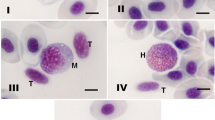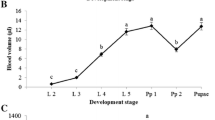Summary
In order to investigate haematopoiesis in the freshwater pulmonate Lymnaea stagnalis, the blood cells and the connective tissue of this snail were studied by light and electron microscopy as well as by autoradiography.
In the circulating blood only one type of cell, the amoebocyte, is present. Amoebocytes also occur in the connective tissue (tissue amoebocytes) as single cells, in small groups or in large accumulations. Study of the morphology and ultrastructure of blood and tissue amoebocytes shows that no differences exist between these cells, indicating that L. stagnalis does not possess a well-defined haematopoietic organ. This assumption is supported by the following observations: 1. both blood and tissue amoebocytes can act as phagocytes, 2. blood and tissue amoebocytes both have the capacity to divide (i.e. incorporate tritiated thymidine) and 3. the percentage of dividing cells in the blood and in the connective tissue is the same. These quantitative data indicate furthermore that there is no difference in the relative importance of the blood and the connective tissue in the process of haematopoiesis.
Comparison of tritiated thymidine labelled cells with unlabelled amoebocytes showed that these cells do not differ with respect to their morphology and ultrastructure. Moreover, amoebocytes involved in phagocytosis and encapsulation of foreign materials or in wound healing still have the capacity to divide.
The percentages of tritiated thymidine labelled amoebocytes in different snails varied considerably. It is suggested that this variation reflects differences in the physiological state of the individual snails.
Similar content being viewed by others
References
Bekius, R.: The circulatory system of Lymnaea stagnalis (L.). Neth. J. Zool. 22, 1–58 (1972)
Brown, A. C., Brown, R. J.: The fate of thorium dioxide injected into the pedal sinus of Bullia (Gastropoda: Prosobranchiata). J. exp. Biol. 42, 509–519 (1965)
Cheng, T. C., Rifkin, E.: Cellular reactions in marine molluscs in response to helminth parasitism. Amer. Fish. Soc. spec. publ. 5, 443–496 (1970)
Cuénot, L.: Études sur le sang et les glandes lymphatiques dans la série animale. Arch. Zool. exp. gén. (Sér. 2) 9, 13–90 (1891)
Cuénot, L.: Études physiologiques sur les gastéropodes pulmonés. Arch. Biol. (Liège) 12, 683–740 (1892)
Cuénot, L.: Les organes phagocytaires des mollusques. Arch. Zool. exp. gén. 54, 267–305 (1914)
Feng, S. Y., Feng, J. S., Burke, C. N., Khairallah, L. H.: Light and electron microscopy of the leucocytes of Crassostrea virginica (Mollusca: Pelecypoda). Z. Zellforsch. 120, 222–245 (1971)
George, W. C., Ferguson, J. H.: The blood of gastropod molluscs. J. Morph. 86, 315–327 (1950)
Haughton, I.: Amoebocytes and allied cells in invertebrates. J. micr. Soc. 54, 246–262 (1934)
Jones, J. C.: Hematopoiesis in insects. In: Regulation of hematopoiesis (ed. A. S. Gordon), p. 7–65. New York: Appleton-Century Crofts, Educational Division 1970
Joosse, J., Lever, J.: Techniques of narcotization and operation for experiments with Lymnaea stagnalis (Gastropoda, Pulmonata). Proc. kon. ned. Akad. Wet. C 62, 145–149 (1959)
Kinoti, G. K.: Observations on the infection of bulinid snails with Schistosoma mattheei. II. The mechanism of resistance to infection. Parasitology 62, 161–170 (1971)
Kress, A.: Untersuchungen zur Histologie, Autotomie und Regeneration dreier Doto-Arten Dato coronata, D. pinnatifida, D. fragilis (Gastropoda, Opisthobranchiata). Rev. suisse Zool. 75, 235–303 (1968)
Müller, G.: Morphologie, Lebenslauf und Bildungsort der Blutzellen von Lymnaea stagnalis L. Z. Zellforsch. 44, 519–556 (1956)
Narain, A. S.: The amoebocytes of lamellibranch molluscs, with special reference to the circulating amoebocytes. Malacol. Review 6, 1–12 (1973)
Pan, C.: The general histology and topographic microanatomy of Australorbis glabratus. Bull. Mus. comp. Zool. Harv. 119, 237–299 (1958)
Romeis, B.: Mikroskopische Technik. 16th edition. München-Wien: R. Oldenbourg 1968
Sminia, T.: Structure and function of blood and connective tissue cells of the fresh water pulmonate Lymnaea stagnalis studied by electron microscopy and enzyme histochemistry. Z. Zellforsch. 130, 497–526 (1972)
Sminia, T., Pietersma, K., Scheerboom, J. E.M.: Histological and ultrastructural observations on wound healing in the freshwater pulmonate Lymnaea stagnalis. Z. Zellforsch. 141, 561–573 (1973)
Sokal, R. R., Rohlf, F. J.: Biometry. The principles and practice of statistics in biological research. W. H. Freeman and Company San Francisco: 1969
Stang-Voss, C.: Zur Ultrastruktur der Blutzellen wirbelloser Tiere. III. Über die Haemocyten der Schnecke Lymnaea stagnalis L. (Pulmonata). Z. Zellforsch. 115, 69–78 (1970)
Tripp, M. R.: Defense mechanisms of molluscs. J. reticuloendoth. Soc. 7, 173–182 (1970)
Wagge, L. E.: The activity of amoebocytes and of alkaline phosphatases during the regeneration of the shell in the snail, Helix aspersa. Quart. J. micr. Sci. 92, 307–321 (1951)
Wagge, L. E.: Amoebocytes. Int. Rev. Cytol. 4, 31–78 (1955)
Weiss, L.: The cells and tissues of the immune system. Structure, functions, interactions. Prentice-Hall foundations of immunology series. Englewood Cliffs, New Jersey: Prentice-Hall, Inc. 1972
Author information
Authors and Affiliations
Additional information
The author is greatly indebted to Dr. H. H. Boer for his valuable criticism during the investigations and the preparation of the manuscript, to Prof. Dr. J. Lever for reading the manuscript, to Dr. J. C. Jager for statistical advice, to Dr. N. W. Runham and Dr. N. Spronk for advice on the use of autoradiographical techniques and to Miss Benita Plesch for correcting the English text.
Rights and permissions
About this article
Cite this article
Sminia, T. Haematopoiesis in the freshwater snail Lymnaea stagnalis studied by electron microscopy and autoradiography. Cell Tissue Res. 150, 443–454 (1974). https://doi.org/10.1007/BF00225968
Received:
Issue Date:
DOI: https://doi.org/10.1007/BF00225968




